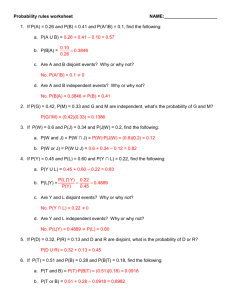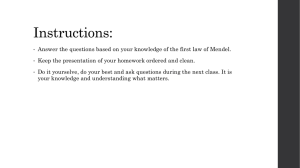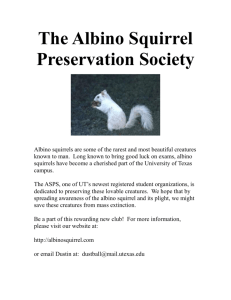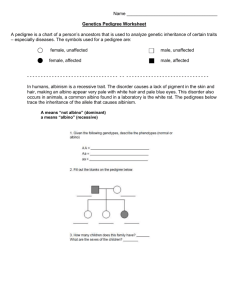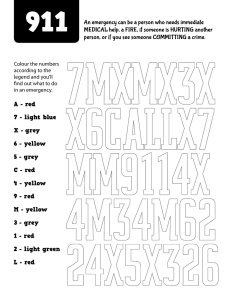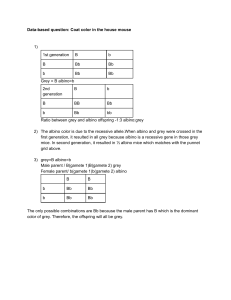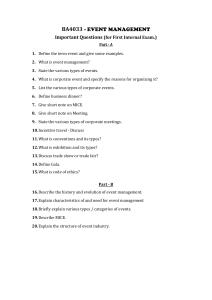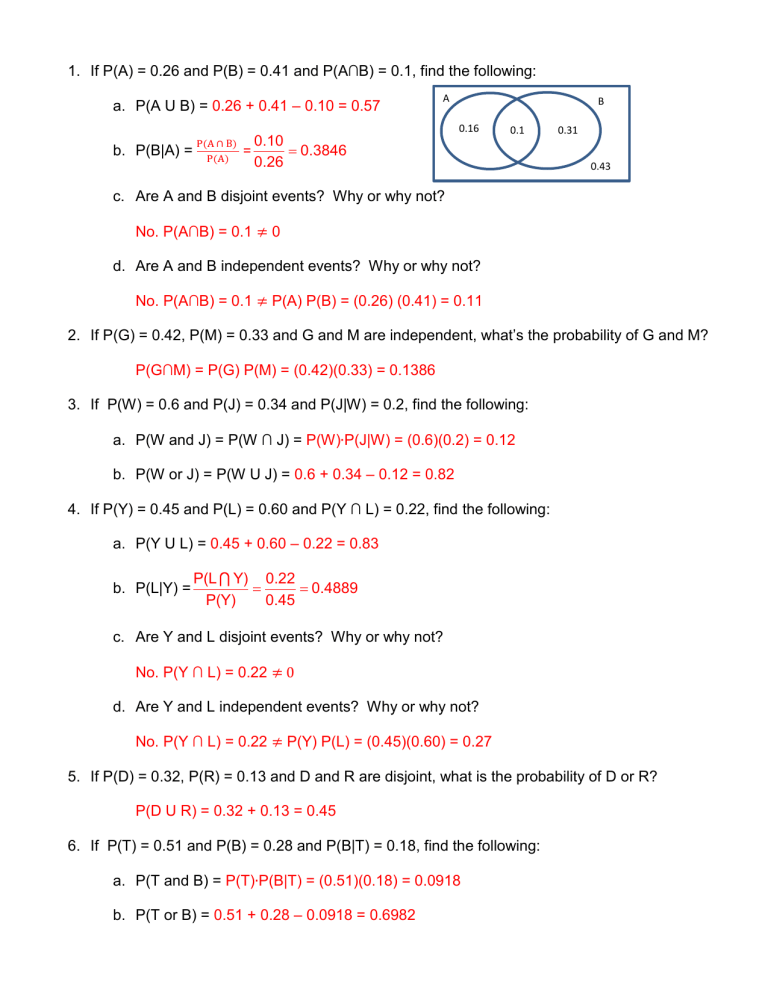
1. If P(A) = 0.26 and P(B) = 0.41 and P(A∩B) = 0.1, find the following: a. P(A U B) = 0.26 + 0.41 – 0.10 = 0.57 A B 0.16 b. P(B|A) = P(A ∩ B) P(A) 0.10 0.3846 = 0.26 0.1 0 0.31 0.43 c. Are A and B disjoint events? Why or why not? No. P(A∩B) = 0.1 ≠ 0 d. Are A and B independent events? Why or why not? No. P(A∩B) = 0.1 ≠ P(A) P(B) = (0.26) (0.41) = 0.11 2. If P(G) = 0.42, P(M) = 0.33 and G and M are independent, what’s the probability of G and M? P(G∩M) = P(G) P(M) = (0.42)(0.33) = 0.1386 3. If P(W) = 0.6 and P(J) = 0.34 and P(J|W) = 0.2, find the following: a. P(W and J) = P(W ∩ J) = P(W)∙P(J|W) = (0.6)(0.2) = 0.12 b. P(W or J) = P(W U J) = 0.6 + 0.34 – 0.12 = 0.82 4. If P(Y) = 0.45 and P(L) = 0.60 and P(Y ∩ L) = 0.22, find the following: a. P(Y U L) = 0.45 + 0.60 – 0.22 = 0.83 b. P(L|Y) = P(L Y) 0.22 0.4889 P(Y) 0.45 c. Are Y and L disjoint events? Why or why not? No. P(Y ∩ L) = 0.22 ≠ 0 d. Are Y and L independent events? Why or why not? No. P(Y ∩ L) = 0.22 ≠ P(Y) P(L) = (0.45)(0.60) = 0.27 5. If P(D) = 0.32, P(R) = 0.13 and D and R are disjoint, what is the probability of D or R? P(D U R) = 0.32 + 0.13 = 0.45 6. If P(T) = 0.51 and P(B) = 0.28 and P(B|T) = 0.18, find the following: a. P(T and B) = P(T)∙P(B|T) = (0.51)(0.18) = 0.0918 b. P(T or B) = 0.51 + 0.28 – 0.0918 = 0.6982 7. Suppose in a lab 24% of the mice are albino, 56% are brown, and the rest are grey. a. What is the probability that a randomly selected mouse is: i. Grey P(G) = 0.20 ii. Not albino P(AC) = 0.76 iii. Grey or Albino P(G U A) = 0.44 b. If the type of mouse is independent of the next what is the probability that: i. 2 randomly selected mice are both brown? P(B ∩ B) = (0.56)(0.56) = 0.3136 ii. 2 randomly selected mice are albino then brown? P(A ∩ B) = (0.24)(0.56) = 0.1344 iii. 2 randomly selected mice are albino and grey? P(A ∩ G) = (0.24)(0.20)*2 = 0.096 iv. Any of 2 randomly selected mice are not grey? P(GC ∩ GC) = (0.80)(0.80) = 0.64 Or P(2 are not grey) = P(A ∩ B) + P(B ∩ A) + P(A ∩ A) + P(B∩B) = (0.24)(0.56)*2 + (0.24)(0.24) + (0.56)(0.56) = 0.64 v. At least 1 out of 4 randomly selected mice is albino? Sorry this question is related to COMBINATION ()المعذرة هذا الموضوع غير داخل في مادة اإلمتحان vi. The first albino mouse is the 5th one selected? Sorry this question is related to COMBINATION ()المعذرة هذا الموضوع غير داخل في مادة اإلمتحان 8. In the parking lot of the a large mall 64% of cars are foreign made, 12% are the color blue and 7.7% are blue and foreign made cars. B F a. Draw a Venn Diagram .563 .077 .043 .317 b. What is the probability that a randomly selected car was: i. A foreign car or a blue car? P(F U B) = P(F) + P(B) - P(F ∩ B) = 0.64 + 0.12 – 0.077 = 0.683 ii. Not a foreign car and a blue car? P(FC ∩ B) = P(B) – P(F ∩ B) = 0.12 - 0.077 = 0.043 iii. A foreign car given it was blue? P(F|B) = P(F ∩ B) P(B) = 0.077 0.12 = 0.6417 iv. Not blue given it was not a foreign car? P(BC|FC) = P(𝐵𝑐 ∩𝐹 𝑐 ) P(𝐹 𝑐 ) = P((F U B)𝑐 ) 1−P(F) = 1−P(F U B ) 1−0.64 = 1−0.683 = 0.36 0.317 0.8806 0.36 c. Is being a foreign car and being blue mutually exclusive? Independent? Not Mutually Exclusive because P(F ∩ B) = 0.077 ≠ 0 ()غير داخل Independent because P(F∩ B) = 0.077 = P(F) P(B) = 0.077 9. The following table shows the breakdown of sex and degree among a university’s faculty. What is the probability that a randomly selected professor is a. Male and has a Doctorate P(Male ∩ D) = b. 28 0.4242 66 Male or has a Doctorate P(Male U D) = P(Male)+P(D)-P(Male ∩ D) = 46/66 + 40/66 – 28/66 = c. Is a Male given they have a Doctorate P(Male|D) = d. P(Male ∩ D ) P(D) = 28/66 40/66 = 28 0.70 40 A female given a Masters degree P(Masters|F) = e. 58 0.8788 66 P(Masters ∩ F ) P(F) 8/66 = 20/66 = 8 0.40 20 Is sex and degree independent? Disjoint? Independent: Yes. P(Male ∩ D) = 0.42 = P(Male) P(D) = (46/66) (40/66) = 0.42 Disjoint: No. P(Male ∩ D) = 0.4242 ≠ 0
